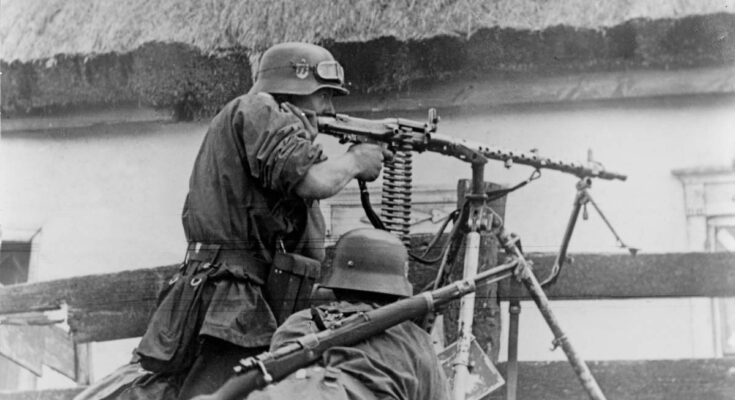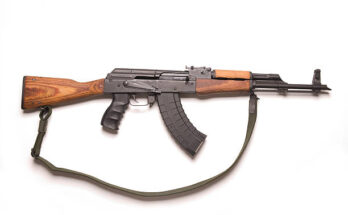The MG34 (Maschinengewehr 34, or “Machine Gun 34”) was a German general-purpose machine gun that played a crucial role in the military during World War II and is considered one of the most important firearms of the 20th century. Here’s a detailed look at its history:
Development and Design
The MG34 was developed in the early 1930s by Heinrich Vollmer and his team at Mauser in response to the growing need for a versatile, high-rate-of-fire machine gun. Germany, after being restricted in military production by the Treaty of Versailles, sought to rearm in the early 1930s under Adolf Hitler’s regime.
The goal was to create a machine gun that could serve multiple roles on the battlefield: as a light machine gun, medium machine gun, and vehicle-mounted weapon. The result was the MG34, which was capable of both air-cooled and water-cooled configurations, allowing it to be used flexibly in various combat situations.
Features of the MG34
- Caliber: 7.92×57mm Mauser
- Weight: Around 12-13 kg (26–28 lbs), making it heavier than many of its contemporaries
- Rate of Fire: 800 to 1,200 rounds per minute, depending on the model and conditions.
- Ammunition: Belt-fed, with either 50 or 250-round belts.
- Construction: The MG34 was made of high-quality steel and featured a recoil-operated, air-cooled mechanism. It also had a distinctive quick-change barrel design, allowing crews to swap out the barrel to prevent overheating during sustained fire.
Operational Role
The MG34 was a versatile weapon, capable of being used in a variety of roles:
- Light Machine Gun: It could be carried by infantrymen and fired from the shoulder, though it was quite heavy for this purpose. It was often deployed in the “squad automatic” role and could provide suppressive fire in infantry combat.
- Medium Machine Gun: When mounted on a tripod or vehicle, it became a more stable, sustained-fire weapon capable of longer-range support.
- Vehicle-Mounted Gun: The MG34 was also adapted for use in various armored vehicles and aircraft, where it was often paired with other machine guns or mounted as a primary weapon in early-war German tanks, half-tracks, and other vehicles.
- Anti-Aircraft: In some configurations, the MG34 was used as an anti-aircraft gun, particularly in its high-rate-of-fire role, though it was soon replaced by more specialized anti-aircraft guns like the MG42.
Operational History in World War II
The MG34 was first introduced in 1934 and was widely used by the German Wehrmacht in the years leading up to and during World War II. It quickly became the standard machine gun of the German army and was used extensively throughout the war. Some key operational highlights include:
- Blitzkrieg Tactics (1939-1941): During the early phases of the war, the MG34 was instrumental in Germany’s rapid victories in Poland, France, and the early stages of the Soviet invasion. The gun’s high rate of fire and flexibility made it a key component in the German strategy of mobile warfare, where fast-moving units relied on sustained fire support.
- D-Day and the Normandy Invasion (1944): The MG34 was still in use by German forces during the D-Day landings and the subsequent battles in Normandy, where it was often deployed in defensive positions.
- Eastern Front (1941-1945): On the Eastern Front, the MG34 was heavily used in combat against the Soviet Red Army. Its ability to fire in sustained bursts made it particularly effective in the brutal conditions of large-scale battles, although it was prone to overheating.
Transition to the MG42
Despite its success, the MG34 was not without its flaws. The main drawbacks were its complexity and cost to manufacture, as well as its relatively fragile construction compared to more robust designs. These issues led to the development of the MG42 in the early 1940s, which was designed to be simpler, cheaper, and more durable, while maintaining the high rate of fire that was a key tactical advantage of the MG34.
The MG42 also used the same 7.92×57mm Mauser ammunition, allowing it to replace the MG34 in many roles. However, the MG34 did not disappear entirely—it continued to serve alongside the MG42 throughout the war and was still found in use on various fronts. Some units even preferred the MG34’s greater accuracy over the MG42’s higher rate of fire.
Post-War Legacy
After World War II, the MG34 was largely phased out of service with the German military in favor of newer, more efficient designs like the MG42 and its successors. However, the MG34’s design influenced future generations of machine guns. In particular, the MG42’s faster production rate and simplicity were directly influenced by the MG34’s experience.
In post-war years, surplus MG34s were sold to various countries and were used by other armies during the Cold War, especially in the Middle East and Asia. Some were also adapted for use in civilian settings, like law enforcement or even hunting, due to their durability and the availability of ammunition.
Conclusion
The MG34 was one of the most innovative machine guns of its time, setting the standard for many future designs and influencing automatic weapon development throughout the 20th century. Its versatile design, high rate of fire, and reliability in combat made it a symbol of the German military machine during World War II. While it was eventually superseded by the MG42, the MG34’s legacy continued to influence the design of machine guns for many years.


